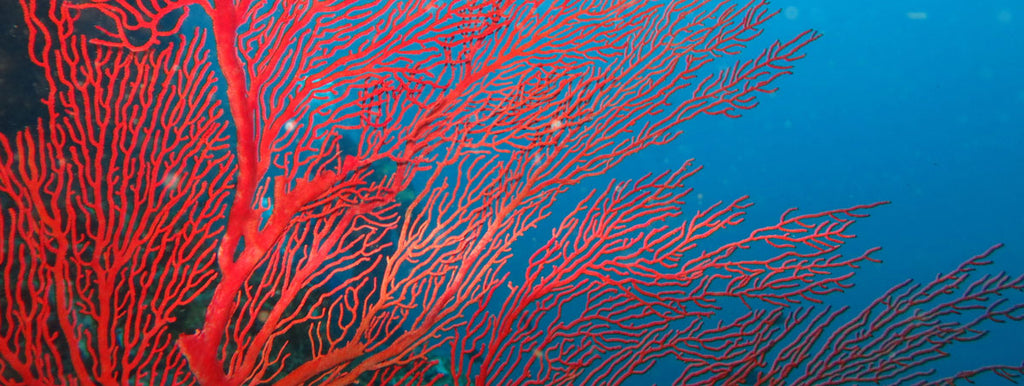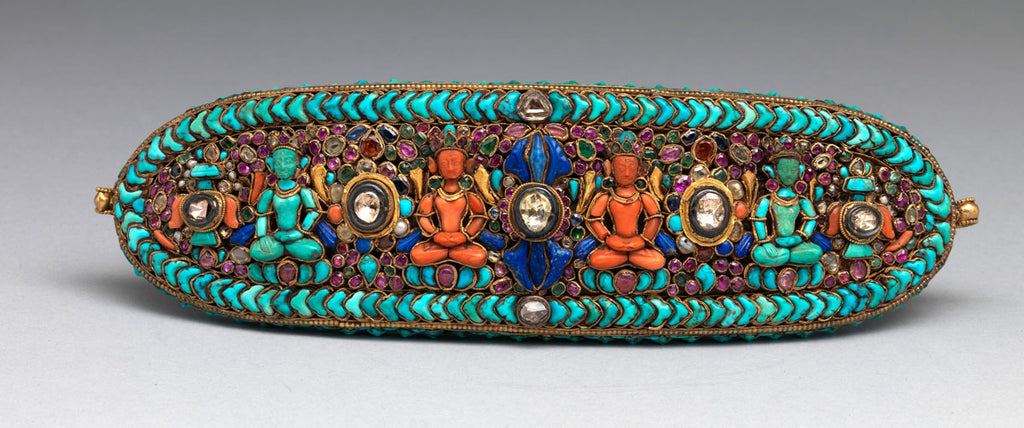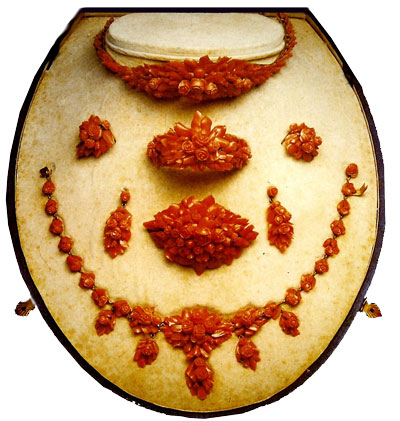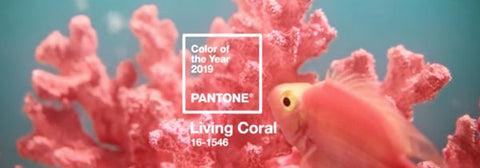The History of Coral Jewelry

By Meg Carter
The ocean and beach have never failed to provide an endless stream of inspiration for artists. Since the beginning of history, ocean/beach-found objects and shapes have found their way into songs, paintings, architecture, sculpture, and many other artistic works. Jewelry in particular has seen the ocean’s influence in design and material. Among these inspirations is coral—with a broad past, an interesting story, and an uncertain future.
Red, pink, orange, and black are among the most sought after colors of coral used in jewelry. These colors are typically found in the Mediterranean Sea, off the coast of Hawaii, near the Strait of Gibraltar, at the Cape Verde Islands (located off the coast of West Africa), off the coast of Portugal, and around Japan and Taiwan. Harvested coral is usually cut and polished into cabochons, shaped into beads or carved. The part of coral that is used for jewelry is actually not the living organism, but rather its carbonate secretions, which form the structure that the polyps live on, and although it is not the living part of the animal, it is essential for its survival.
In 77 AD, Pliny the Elder wrote in depth about coral in one of the earliest encyclopedias, Naturalis Historia (Natural History). Pliny describes the most valued coral as the reddest and most branchy. Red coral, corallium rubrum, was thought to have amulet powers for warding off dangers. It was also viewed as a thing of beauty and powerfully religious.
During this period, Pliny claims that the Gauls used coral as ornamentation on their swords, shields, and helmets. The power of coral also followed into medicinal purposes. Reduced to powder or by burning and ingesting, it was said to help with ailments such as bladder problems, fever, ulcers, and scarring. The value of coral was so high that it was not commonly traded where it was harvested but rather brought to areas with higher wealth.
Coral viewed as an amulet spread far around the world. In 7000 Years of Jewelry, Hugh Tait describes coral as “a material to which in the ancient world great amuletic powers had been attributed. It was said, according to Greek mythology, to have originated as the spurts of blood gushing forth after Medusa’s head had been severed by Perseus.”

Newari jewelry for Nepal or Tibet market. Gold, diamonds, rubies, emeralds, sapphires, garnet, lapis lazuli, coral, shell, and turquoise, 17th–19th century, Metropolitan Museum of Art
Hundreds of years ago, coral was thought to be a protection against magic spells. These beliefs were especially thought of in regards to children. From Spain to Italy in historical portraits, infants are shown holding coral branches.
Throughout the centuries, coral has held steady as a medium in jewelry. According to the book Gems and Gemstones by Lance Grande and Allison Augustyn, “The use of coral as a gemstone is an extremely ancient practice, going back at least 25,000 years. Coral has been found in ancient Egyptian tombs and prehistoric European burial sites.” Coral can be found in historic jewelry from Tibet in as early as the 17th century.

The Italians have always been known for their exquisite jewelry, and their use of coral is no exception. Through the 1800 and 1900s elaborate coral carvings were produced in Naples and throughout Italy. Techniques and styles from Italy spilled over to the U.S. in the late 1800s and jeweler Tiffany & Co. began using coral in their pieces.

La infanta Ana Mauricia de Austria, Juan Pantoja de la Cruz, 1602
Today, coral has a different appeal. “Living Coral” has been announced as Pantone’s 2019 color of the year. “Living Coral” (whether Pantone intended it or not) is an ironic title when it comes to the story of coral. Pantone describes the color as “an animating and life-affirming coral hue with a golden undertone that energizes and enlivens with a softer edge.” Although Pantone is describing the color, the actual marine invertebrates are definitely struggling with the “life-affirming” part.

The world’s coral reefs are threatened by pollution, overharvesting, and climate change. Several species of coral have been declared endangered and are now regulated, and more than 180 countries restrict the export of red coral harvested after 1969.
Today, the use of coral in jewelry is controversial. Coral jewelry is still popular, and vintage pieces fetch astronomical prices at auction. While some jewelers continue to use coral in their designs, many jewelers only use coral repurposed from vintage pieces and others have stopped creating coral jewelry altogether.

Tiffany & Co. Earrings and Brooch. Coral and gold,1854–70, Metropolitan Museum of Art
In 2002, Tiffany & Co. stopped using natural coral in all of their jewelry designs. Along with this change, they have also played an active role in coral conservation. Over the past 16 years, Tiffany has donated $75 million to organizations dedicated to stewardship of natural resources, including coral and marine conservation.
The jewelry industry has done damage to the world’s coral reefs over hundreds of years, but changes going forward will make a difference. With fewer jewelers using coral, the reefs will have a better chance of recovering. And, until then, coral lovers can buy beautiful antique coral jewelry pieces, or if they’re lucky, see coral living in the wild.
This article appeared in the Beachcombing Magazine March/April 2019 issue
1 comment
Was red coral ever used on watches movement ad jeweis?






